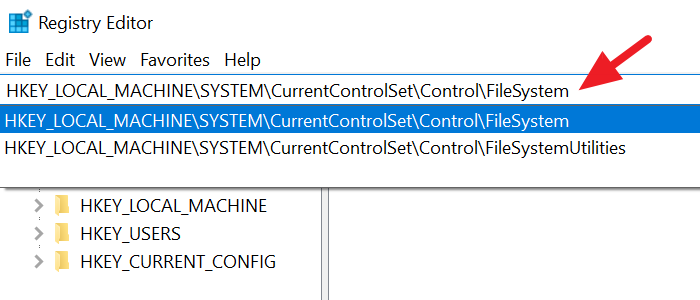

- #LONG PATH TOOL KEY NOT WORKING FULL#
- #LONG PATH TOOL KEY NOT WORKING SOFTWARE#
- #LONG PATH TOOL KEY NOT WORKING CODE#
- #LONG PATH TOOL KEY NOT WORKING WINDOWS#
#LONG PATH TOOL KEY NOT WORKING SOFTWARE#
You can use the following command to make a link: mklink /d c:\homelink “C:\verylongpathhere……” Solution 3: Make use of the Subst UtilityĪnother method is to use the built-in software Subst to associate the problematic folder with a virtual drive (in our case, Z:). Solution 2: Make a Symbolic ConnectionĪnother alternative is to build a symbolic link to a section of the path, reducing the overall path length. The simplest method is to simply rename the parent folders to reduce their names, hence reducing the total path length (though this is not always possible).
#LONG PATH TOOL KEY NOT WORKING FULL#
Solution 1: Reduce the Full Path by renaming the parent folder. You can try again by shortening the file name or moving to a location with a shorter path. The route to the destination is very long.įor the destination folder, the file name(s) would be too long. Lost of files during migration and data transfer between servers, etc.Incorrect calculation of the directories size.Errors data recovery from shadow copies.Errors when synchronizing roaming profiles.Users can create files and folders in a shared network folder that the administrator (or management scripts) cannot access locally.The absolute file path, for example, might look like this: \\?C:\folder1\subfolder1\toolongfilenameĭue to max path length limitations, the administrator may encounter the following problems: To get around the constraints of the Win32 API, some programs employ the UNC file path format (prefixed with?). Many third-party programs (such as popular file managers as FAR and Total Commander) can now process files/folders with paths longer than 256 characters without issue. It’s possible to use a path of up to 32767 characters when utilizing Unicode API calls.
#LONG PATH TOOL KEY NOT WORKING WINDOWS#
Windows recognizes the full path, beginning at the root of the drive and ending with the last subfolder, as well as the file name itself, under the file name.

With large path files surpassing 256 characters, most typical apps, including Windows Explorer (File Explorer), do not work effectively. The MAX PATH value in the Win32 API is 260. This is a limitation of the Win32 API library, not the NTFS file system. Windows XP, Windows 7, Windows 8, Windows 10, Windows Server 2003, Windows Server 2008, and Windows Server 2012R2/2016/2019 are all supported. The error occurs because File Explorer was unable to copy, delete, or rename any path with a name greater than 256 characters. Close the Group Policy Editor and restart your PC.Try the fast trick below if you get the error Destination Path Too Long when copying or moving a file to a folder.Double-clickon it, and set it to Enabled.Instead of Enable NTFS long paths, you could also have Enable Win32 long paths in the Filesystem folder. Once opened, navigate to Computer Configuration > Administrative Templates > System > Filesystem > Enable NTFS long paths.Here, type gpedit.msc and press enter to open the Group Policy Editor. Enable Long File Paths from Group Policy Editor You can also use Group policy editor to make set bypass the 260 character limit on Windows 10. Windows Registry Editor Version 5.00 "LongPathsEnabled"=dword:00000001 Open the file and accept the confirmation to add the value to the registry. Now, save that file as bypass_character_limit.reg on the Desktop.

#LONG PATH TOOL KEY NOT WORKING CODE#
Set it’s value to 1 from 0 and click OK.Īlternatively, you can copy the code written below into a notepad and use it for changing the registry key.įor doing that, open notepad and paste the code written below in it.Once FileSystemis highlighted, double-click on the LongPathsEnabled key.In the registry editor, navigate to HKEY_LOCAL_MACHINE\SYSTEM\CurrentControlSet\Control\FileSystem.Here, type regedit and press enter to open the Registry editor. Enable Long File Paths from Registry EditorĢ. Continue reading below for the instructions. Of course, this feature is opt-in, and that’s why this you have to manually edit the registry for enabling it. To bypass this limit, you can use the Registry editor, or the Group policy editor and enable the Long file paths for Windows. Enabling this setting will cause the long paths to be accessible within the process. The official help doc also says the same thing as you can read below:Įnabling Win32 (NTFS) long paths will allow manifested win32 applications and Windows Store applications to access paths beyond the normal 260 character limit per node on file systems that support it. If you still don’t understand it, take a look at the error message below. This error message pops up when the length of a location becomes larger than 260 characters.

Or the Source path too long or the Path is too deep. What I am talking about is the irritating message that goes like The file name is too long. The overly annoying 260 character limit for pathname is finally avoidable.


 0 kommentar(er)
0 kommentar(er)
